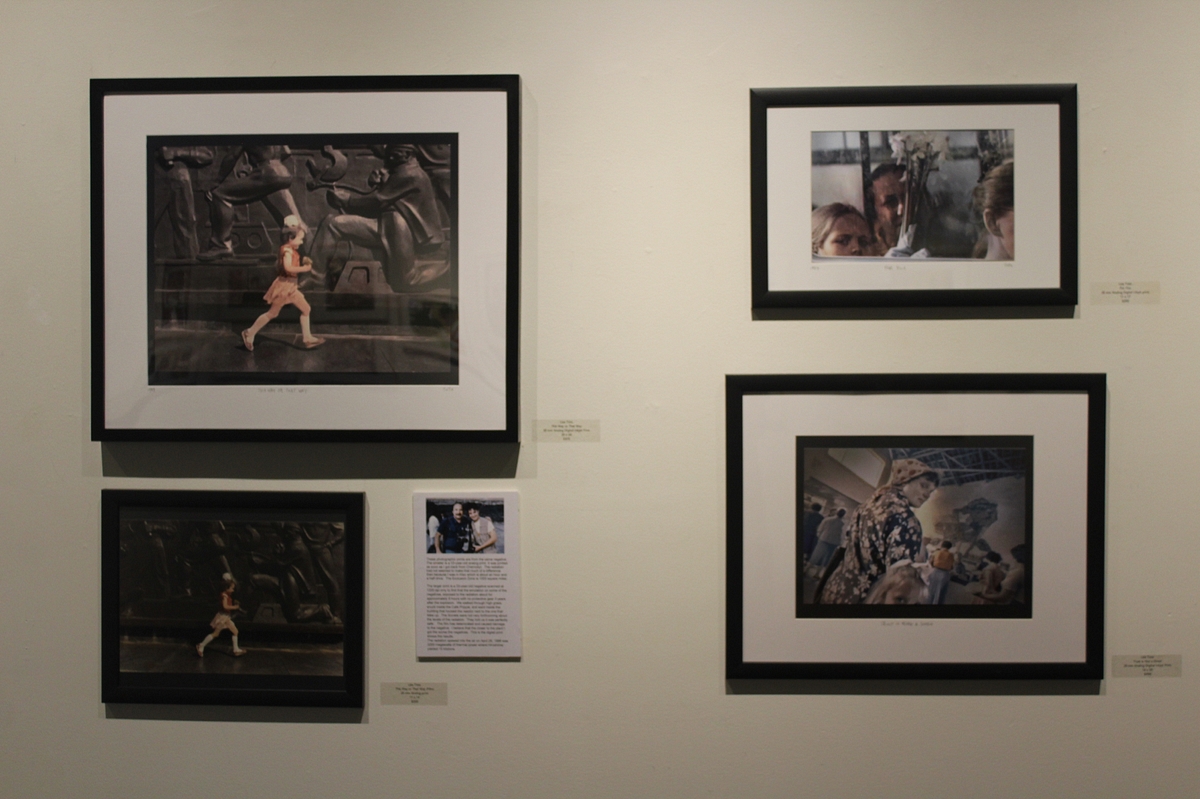
The centerpiece of Lisa Toto’s part of the latest show at Kehler Liddell Gallery — running now through Feb. 5, and also featuring works by Hank Paper and Chris Ferguson — is two prints of the same image, of a young girl in a dress running by a relief. She exudes joy, but there’s something wrong.
While one version of the image is crisp and clear, the other is faded and degraded. The reason why comes into focus as the viewer understands that the image is taken from a photography visit Toto took to Chernobyl in 1989, three years after the nuclear accident there that rendered a swath of Ukraine uninhabitable, scientists say, for the next three millennia.
“These photographic prints are from the same negative. The smaller is a 33-year-old analog print. It was printed as soon as I got back from Chernobyl. The radiation had not seemed to make that much of a difference then because I was in Kiev which is about an hour and a half drive. The Exclusion Zone is 1,000 square miles,” Toto writes in an accompanying statement. “The larger print is a 33-year-old negative scanned at 1,200 dpi only to find that the emulation on some of the negatives exposed to the radiation for approximately 8 hours with no protective gear 3 years after the explosion. We walked through high grass, snuck inside the Cafe Pripyat, and went inside the building that housed the reactor next to the one that blew up. The Soviets were not very forthcoming about the levels of the radiation. They told us it was perfectly safe. The film has deteriorated and caused damage to the negative. I believe that the closer to the plant I got the worse the negatives. This is the digital print that shows the results.”
Toto was “only 24 when her press credentials got her behind the Iron Curtain,” she writes. “From an assignment that took her from Odessa to Kiev with a national organization, she wriggled her way into an assignment to shoot the aftermath of history’s worst nuclear disaster.” The photos in her segment of the current show, “Chernobyl 1989,” “are Toto’s view of that 8+ hours, as seen through the photos of the people who suffered needlessly. Toto wanted to tell this story about ignorance, secrecy and the disregard for humanity, and came away knowing that this was no accident but an intended disaster to enrich the powerful.”
The photos amply do the rest of the talking. A black and white photo of a discarded shoe makes the viewer wonder whether it was lost entirely in flight, during the sudden evacuation of the zone shortly after the meltdown. But much of the power of the photos comes from Toto’s images of regular people, whom Toto captures seemingly getting on with their lives. But what has happened to them now? We have learned much about the nuclear disaster’s horrific aftermath, on the next generation and likely future generations.

Toto’s images, focusing on how the lives of so many people were irrevocably altered in a flash, lends additional poignancy to the works on the neighboring walls by Hank Paper and Chris Ferguson. Paper’s photographs are grouped together as “Solo Stories & Landscapes + 4 Duets” with photographer Sage Damelin. “These pictures show moments of beauty and surprise with each image telling a story; ‘who we essentially are in those moments that would otherwise miss the eye if the camera had not serendipitously recorded them,’ ” an accompanying note reads. “Also, Paper and Damelin exhibit ‘duets’ which show two images, side by side, to resonate and provoke new meaning.” In proximity to Toto’s photographs, there is a sense of overwhelming luck to Paper’s and Damelin’s pieces, a rekindling of a sense of wonder. Focused with a clearer sense of how fragile those everyday moments can be, perhaps the viewer comes closer to understanding what the photographers were feeling at the time, and the impulses that made them snap the photo in the first place.

Toto’s images also amplify Chris Ferguson’s part of the show, entitled “Finding Solace.” As an accompanying note explains, Ferguson “spent his painting time finding solace by depicting dear ones throughout the pandemic. Here he has painted ‘directly from creation,’ which he feels is the best way to learn and improve; ‘it’s my goal to continue this practice.’ With such specific subject matter and process, Ferguson exhibits his gratitude deeply in this series of new work.” Ferguson has always had a knack for infusing his subjects, whether people or landscapes, with an internal light. That predilection is on ample display in his newest works. He helps us see where we live again, with a new sense of thanks, whether it’s the cherry blossoms in Wooster Square, the water flowing serenely under a bridge, or a small house on a rainy day.
“Chernobyl 1989,” “Solo Stories and Landscapes + 4 Duets,” and “Finding Solace” run at Kehler Liddell Gallery, 873 Whalley Ave., through Feb. 5. Visit the gallery’s website for hours and information.